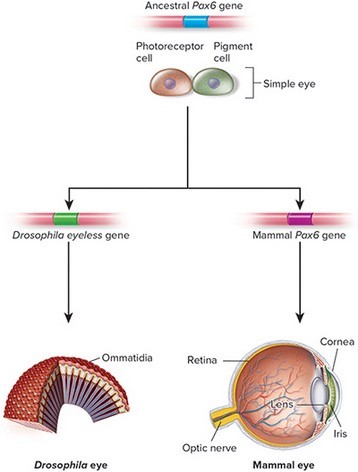The figure below illustrates that 
A. most animal species have eyes with one photoreceptor and one pigment cell.
B. the retina and cornea developed first, but then were secondarily lost in insects such as Drosphilia.
C. genetic changes in an ancestral Pax6 gene contributed to the evolution of the mammal eye, while the Drosphilia eye arose independently.
D. eye complexity has not significantly increased since the late Triassic when most modern insect families arose.
E. although the mammal eye possesses more cell types and greater complexity than the Drosphilia eye, both arose from genetic changes to an ancestral Pax6 gene.
Answer: E
You might also like to view...
An amino acid that is used as a supplement for breads is ________.
A. proline B. aspartate C. leucine D. lysine
What is the importance of the structure of the
small intestine?
a. The many folds help to mechanically break down food. b. The many folds help to increase the surface area for digestion and absorption. c. The many foods help to slow the food down as it moves through the small intestine. d. choices a, b, and c are all correct. e. none of these are correct
Which of the following populations will have the smallest number of genetically different individuals in it?
A. a population of asexually reproducing lizards initiated by one female B. a small island population of water snakes C. a large cornfield of hybrid corn in Iowa D. the robin population of Michigan
Cardiac muscle cells need to generate significant amounts of ATP to allow for constant contractile activity. As a result, they primarily depend upon beta-oxidation of fatty acids, which has a higher energy yield than the catabolism of glucose. What would be the ATP yield for beta-oxidation of a hypothetical 10-carbon fatty acid?
A. 62 ATP B. 32 ATP C. 65 ATP D. 50 ATP E. 35 ATP